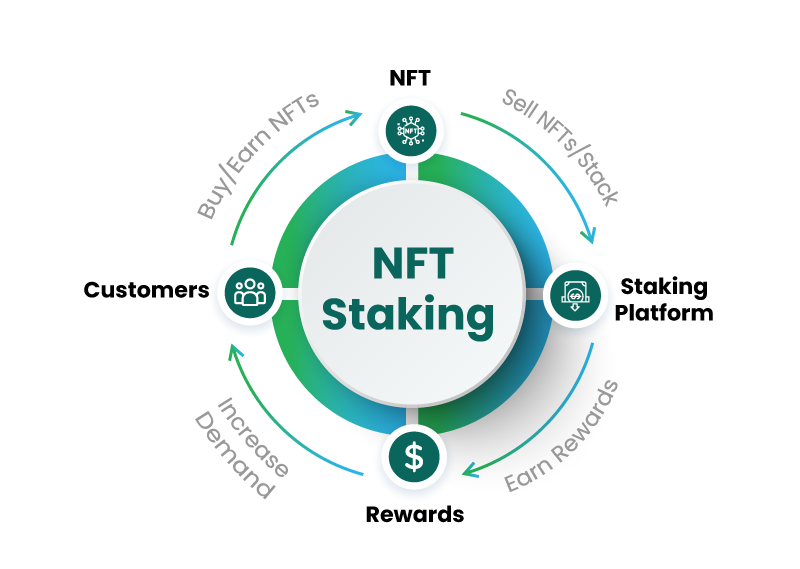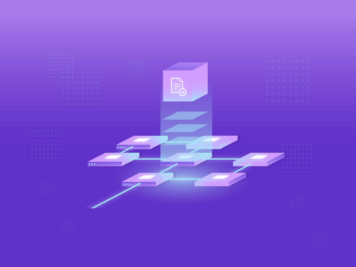Few concepts have recently garnered as much attention as Non-Fungible Tokens (NFTs), especially within the context of the meteoric rise of blockchain and the broader crypto ecosystem. And when NFTs are combined with the established world of DeFi staking, a whole new paradigm of value creation emerges— NFT staking. But what exactly is it? How can it be implemented, and more importantly, how can businesses leverage it for value creation?
What is NFT staking?
NFT Staking is a convergence of decentralized finance (DeFi) and non-fungible tokens (NFTs). It allows NFT owners to stake or deposit their NFTs into a smart contract to earn rewards. It is similar to depositing money in banks to get interest. But it is decentralized, involves NFTs, and rewards can be anything (airline miles, game credits, platform tokens, etc.).
There are multiple ways to stack NFTs, as explained below:
- Simple Staking: The owner can use NFTs to stake on a platform and earn rewards. These rewards can be used to buy other valuable things supported by the platform.
- DeFi Combinations: NFTs can be staked as collateral to mint new tokens. For instance, imagine an NFT-backed stablecoin, where the NFT acts as collateral. It is like using precious artwork as collateral for a loan from a bank.
- Fractional Ownership: Some platforms allow for the fractionalization of NFTs, where the NFT is split into numerous fungible tokens. These tokens can then be staked, traded, or sold.
- NFT Farming: Users stake NFTs to earn NFTs as rewards instead of tokens.
How tech companies are using it?
Many tech companies are seriously looking into use cases of NFT staking to build customer loyalty, stickiness to the business, and additional sources of revenue.
But does it make sense for businesses to invest in NFT staking?
Let’s try to answer it with a use case.
Use Case: Monetization & New Revenue Stream:
Suppose you run a gaming platform similar to Steam but for arcade games. Your users can create a platform, buy games from the platform using real money or the platform’s game credits, and create a library of games to access, download, and play.
Possible revenue stream:
You can offer users the option to buy or earn custom NFTs valued within the gaming community. These NFTs can be used for staking on your platform in exchange for game credits that can be used to purchase additional games. This increases demand for the NFTs, creates a new revenue stream, and serves as a gamification strategy to expand the user base and enhance user loyalty. In essence, this entire process creates a closed ecosystem where a positive feedback loop generates more revenue.

In a similar way, different businesses can try to create a closed ecosystem or even partner with NFT staking platforms to make NFTs more valuable and transferrable.
Now let’s discuss how NFT staking platforms are built.
Implementation overview
Creating an NFT staking platform involves several technical and operational steps. It requires a good understanding of blockchain technology, smart contracts, and decentralized applications (DApps).
Let me make the understanding simpler by explaining the steps with a use case. In this use case, as an example, I will explore the development of a virtual product, ArtStake, an NFT staking platform focused on digital art collectibles. Users can stake their digital art NFTs in exchange for rewards in the form of a custom ERC-20 token named “ARTCOIN.”
Here’s a high-level overview of the steps to implement an NFT staking platform:
1. Define Your Goals and Strategy:
Before going ahead with the actual development process, you must set the following things right-
- Define a clear and compelling use case for your NFT staking platform.
- Determine what benefits NFT holders will receive by staking their tokens, such as earning rewards or gaining access to exclusive content or features.
- Decide what should be the primary objectives of your NFT staking platform.
- Consider factors like the type of NFTs you want to support (art, collectibles, in-game items, etc.), the rewards you’ll offer to stakers (tokens, additional NFTs), and how you plan to attract NFT creators and stakers to your platform.
ArtStake Objective and Strategy: The platform aims to provide a way for users to stake their digital art NFTs and earn rewards.
You can partner with renowned digital artists and offer them a share of ARTCOIN rewards generated from staked NFTs. For example, if an artist’s NFTs are staked on the platform, he/she will receive 10% of the total ARTCOIN rewards earned by stakers of his/her art.
Simultaneously, your platform should also entice collectors to stake their NFTs to earn ARTCOIN rewards. By nurturing this ecosystem of mutual benefit, the platform can create a thriving community where artists gain recognition and collectors get rewards for their commitment.
2. Choose a Blockchain:
Choosing the blockchain that best suits your project should be your next step. The transaction speed of a blockchain platform is important as it can affect the associated transaction costs. Ethereum is a popular choice. With the new Shapella upgrade, Ethereum has launched staking withdrawal features, which has made it more popular among investors. Lido’s plan to release NFTs to represent a user’s withdrawal request is also a booster for Ethereum.
You might consider other options like Binance Smart Chain, Polkadot, or a custom blockchain, depending on your project’s requirements.
ArtStake Blockchain: Ethereum’s wide adoption and extensive support for NFTs make it a popular option. This decision is based on factors such as gas fees, security, and the existing DeFi infrastructure.
3. Set Up Development Environment:
Install and configure the necessary development tools, libraries, and frameworks. NFT staking offers multiple business opportunities in the fields of art, assets, games, and AI-generated assets. Leveraging them requires a proper development environment. To ensure optimum results, install and configure necessary development tools, libraries, and frameworks.
4. Smart Contract Development:
In staking, users commit their cryptocurrency holdings for a specific duration to receive rewards or benefits in return. Smart contracts enable it. But it also manages other aspects of the platform:
NFT Contract: Develop an ERC-721 or ERC-1155 smart contract to represent and manage NFTs. The ArtStake platform NFT should include metadata, such as the artist’s name and description of the artwork.
Staking Contract: Develop a staking smart contract that allows users to stake their NFTs. Ensure that it tracks staked NFTs and calculates rewards accurately. Users can stake their NFTs here, and rewards are distributed based on the staked NFTs’ duration and quantity.
Rewards Distribution: Design a mechanism to distribute rewards, either in the form of tokens (ERC-20) or additional NFTs. The ArtStake rewards distribution contract will mint the ARTCOIN token and distribute it to stakers based on the duration and quantity of NFTs staked.
5. UI Development and Wallet Integration:
User engagement decides the success of an NFT staking platform. They prefer simple NFT staking platforms. Complexity in the design reduces platform uptake.
To increase user engagement, develop a user-friendly DApp frontend that interacts with your smart contracts. This should include creating pages for staking, unstaking, checking rewards, and connecting wallets. If your users find your platform comfortable to use, there is a higher likelihood of the platform generating more revenue.
Wallet integration is crucial for both users and platform providers. It enhances security, convenience, transparency, and trust in NFT staking. It simplifies the process of tracking staking activity, rewards, and withdrawals for the users. Many wallet integrations support multiple blockchains and NFT standards. They make it easier for users to stake diverse NFTs across different ecosystems.
You can integrate some popular blockchain wallets like MetaMask, Trust Wallet, or others to allow users to interact with your DApp using their preferred wallet.
6. Tokenomics and Reward Mechanics:
Simplifying tokenomics and reward mechanics can help you avoid future legal troubles or user dropouts.
- Define the rules for distributing rewards to stakers.
- Consider factors like the amount of rewards, distribution frequency, and whether rewards will be in the form of native tokens or NFTs.
- Design a tokenomics model that outlines how rewards will be distributed among stakers and how new tokens will be minted or distributed. This includes deciding on the inflation rate, if any, and the source of rewards (e.g., transaction fees and external revenue sources).
ArtStake Tokenomics: The tokenomics of ARTCOIN involves a total supply of 1,000,000 tokens, which gets distributed through an initial presale, with a portion reserved for platform development and ecosystem growth.
ARTCOIN operates on an inflationary model, with 10% of new tokens minted each month as rewards for stakers. Users can stake their digital art NFTs to earn ARTCOIN, and the longer they stake, the higher their rewards.
Additionally, a portion of the rewards generated from staked NFTs is allocated to the respective artists as an incentive. ARTCOIN serves a dual purpose: as a reward for staking and as a utility token for platform governance and premium features.
7. Security and Compliance:
You must regularly audit smart contracts for security vulnerabilities.
The platform should comply with copyright and intellectual property laws regarding the listing of digital art NFTs.
If there is a need, consult legal experts to navigate through financial or regulatory compliance requirements.
8. User Onboarding, Marketing, and Community Engagement:
Users often find the staking process difficult to understand as the domain is still a niche one and is experiencing an influx of new users every day. Retaining them on your platform is crucial to generate revenues.
- Create a user-friendly onboarding process that guides users through the staking process.
- Develop a marketing strategy to attract both NFT creators and stakers.
- Include social media marketing, partnerships, and incentives for early adopters in your strategy.
Things to Avoid/ Pitfalls
DigiToad’s recent foray into staking, FOXNFT.IO’s attempts to establish digital brand equity, and Elfin Kingdom’s campaigns are indicators of increasing investment in NFT staking. But the domain itself is still at a nascent stage, which can jeopardize business outcomes. At the same time, reliance on hype without a solid technical and functional foundation can quickly lead to disillusionment and disappointment.
Successful NFT staking implementation requires an understanding of a few considerations, and by knowing them beforehand, decision-makers can certainly benefit.
1. Lack of Security Audits:
Users spend on a platform only when they trust its security. If that security gets compromised, the platform loses its credibility and, subsequently, the customer base. It makes security audits of greatest concern.
Never skip your security audits. Auditing smart contracts can give you a clear idea about their vulnerabilities, which can make your platform susceptible to hacks and exploits.
2. Lack of Clear Purpose
NFT staking is fast emerging as a business strategy. Businesses may want to adopt this trend early to get a competitive benefit, but they can go wrong if they don’t have a clear objective or a strategy.
A lack of objectives can directly impact user participation and engagement. People only invest in staking when they see a clear incentive. Their engagement increases the security and functionalities of the network. But if they see no value in it, they will quickly withdraw tokens from the pool and make the system vulnerable.
3. Unrealistic Rewards
Cryptocurrency and NFT have a history of giving people high returns. These may have done great for platforms but have also given birth to users who only come for short-term gains. If the staking rewards are excessively high, then it can attract similar users. It can also make the token distribution unsustainable.
4. Lack of Regulatory Understanding
Many countries are still uncertain about how to govern and operate with cryptocurrency and blockchains. This makes a proper understanding of the legal implications of the entire staking all the more necessary. Before implementing the technology, legal teams can take a look at the financial activities, securities, taxation, and consumer protection to provide crucial guidance to companies.
Without a proper understanding of the regulations, NFT staking platforms can witness slow growth, miss opportunities, and suffer from government crackdowns.
5. Insufficient Transparency
Users must have clarity about the process, benefits, and potential risks. It can increase their trust in the system and engagement. Staking platforms should be easily understandable for both newcomers and experienced users. Simple staking process and tokenomics can attract a wider range of users.
Complex systems often lead to errors, frustrations, and potential losses. It can substantially impact the longevity of the platform. By building a transparent and simple process, businesses can make understanding regulatory compliance easier for their users.
6. Neglecting User Experience & Feedback
Don’t overlook the importance of user experience. A confusing interface can deter users from engaging with your platform.
Community feedback can make the implementation process simpler and more effective. It can also boost user adoption. Constructive feedback can help with developing a proper exit strategy covering times when businesses can invest in modifying the system or decide to terminate it.
7. Insufficient Liquidity
Inadequate liquidity can make the price volatile and discourage people’s participation. This can lead to unpredictable rewards and losses for users. With a poor number of participants, trading NFTs becomes difficult.
The value proposition of the platform depends on what kind of rewards the platform can offer. If users cannot convert the rewards into assets, they will drop out. It can also affect long-term partnership plans.
Future trends
Recent changes in the NFT staking domain suggest that the market is gaining momentum. There are some clear signs of future trends that may transform the way the industry operates.
The development of financial products linked to staked assets is going to witness a substantial rise in the coming years. Derivative staking can impact the segment. It allows users to stake tokens in exchange for a derivative token. Derivative tokens provide liquidity to the locked asset.
Blockchain interoperability to make cross-chain staking the new norm. It will provide users the flexibility to stake in one platform and use the coin in another.
Shard chains have the potential to enhance Ethereum’s scalability. This can make the ecosystem more sustainable. It can improve the returns significantly.
Liquid staking offers liquidity and staking rewards together. It can become big in the coming years and resolve the liquidity issues by helping stakers make their staked assets liquid.
DSaaS, or Decentralized Staking as a Service, can simplify the staking process. It can remove intermediaries by providing staking services on the blockchain and foster decentralization. Staking-as-a-service platforms can also gain momentum by providing investors with a platform for all the technical requirements.
Conclusion
NFT staking represents a groundbreaking fusion of blockchain and NFTs, empowering users to unlock value from their digital assets. It’s a dynamic avenue for engagement, rewards, and community growth, showcasing the innovative potential of the NFT ecosystem.
But developing the same requires some expertise. We have blockchain experts at Talentica Software who have significant experience in NFT Staking. They can help you set up a new revenue stream and increase user engagement.









